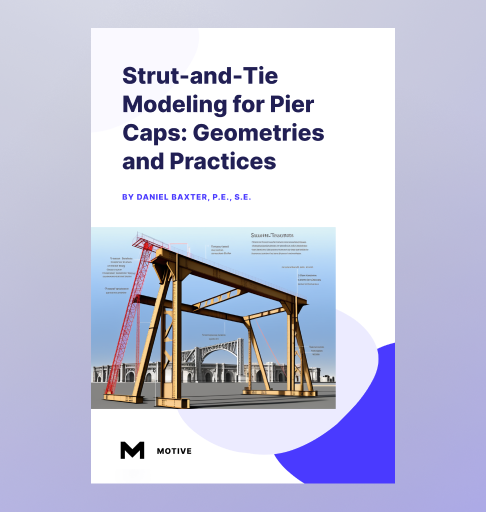(Click the table of contents to navigate to the detailed content)

What is Strut-and-Tie Analysis? What are "Struts" and "Ties" in Strut-and-Tie Analysis?
When is Strut-and-Tie Analysis Needed?
How to Define the Strut-and-Tie Analysis Geometries?
How to Determine the Locations of the Vertical and Diagonal Members in the Strut-and-Tie Model?
How to Determine the Locations of the Vertical and Diagonal Members in the Strut-and-Tie Model?
What are Examples of Good and Bad Strut-and-Tie Models?
What is Strut-and-Tie Analysis? What are "Struts" and "Ties" in Strut-and-Tie Analysis?
Strut-and-tie analysis visualizes the flow of forces through any type of concrete element in the form of internal truss. The tensile members of the internal truss are called "ties" and the compressive members of the internal truss are called "struts" in struct-and-tie analysis. The joints that are needed to join the two types of members together are called "nodes".
When is Strut-and-Tie Analysis Needed?
Strut-and-tie analysis is suitable for regions of concrete structures that are in vicinity of the application of concentrated loads or are subjected to geometry changes. At those locations, often times the sectional analysis of the beam theory are not applicable. Most pier caps are subjected to concentrated loads from the superstructure, which are supported at the bearings. This results in disturbed regions on the pier cap where again, beam theory is not applicable. However, strut-and-tie analysis can perform design of the pier cap in scenario like this.
How to Define the Strut-and-Tie Analysis Geometries?
To perform strut-and-tie analysis for a pier cap shown in figure 1(a), two types of model are created. The first one is a simple frame structure that is modeled using beam elements, as shown in figure 1(b). Superstructure can be included in this model. The second model is a natural strut-and-tie model of the pier cap that represents the internal truss using truss elements in order to model the internal forces.
%20Pier%20cap%20for%20strut-and-tie%20analysis.jpg?width=700&height=330&name=Figure%201.%20(a)%20Pier%20cap%20for%20strut-and-tie%20analysis.jpg)
The first task to define the strut-and-tie analysis structure geometry is by defining the top and bottom ties. They will be placed at the centerlines of the top and bottom longitudinal steel. This is because we are going to use the force in our ties to directly design the reinforcement steel. For some cases where the pier cap might have longitudinal crack control reinforcement, but not all of these bars should be necessarily included as the tie members.
Nodes in the model are going to be placed at the intersection where the bearings of the girders are placed on the pier cap. We also need to place nodes in the model where the pier cap model intersects the columns, and the location of these nodes depends on if the columns are considered fixed support or pinned support to the pier cap. In the example shown in this article, they are considered fixed supports, therefore, the column nodes will be placed at the intersection of the quarter (1/4) points in the column and the steel tie elements at the pier cap bottom.
%20Pier%20cap%20with%20top%20and%20bottom%20longitudinal%20steel%20reinforcement%20shown.jpg?width=700&height=369&name=Figure%202.%20(a)%20Pier%20cap%20with%20top%20and%20bottom%20longitudinal%20steel%20reinforcement%20shown.jpg)
How to Determine the Locations of the Vertical and Diagonal Members in the Strut-and-Tie Model?
Having determined the top and bottom ties and the locations of nodes that represents concentrated loads and supports, the preliminary strut-and-tie model gives a general idea of how the completed geometry would look like. However, to determine the location of additional nodes, vertical members, diagonal members, and additional members, the following steps and rules need to be followed.
- Follow the direct load path (draw structs from girder nodes to the nearest column nodes).
- Follow the 25° rule from AASHTO (no strut/tie should have less than 25° angle in between).
- Use overlapping X-diagonals between all vertical members.
The tensile force in the tie elements are used to design the reinforcing steel members. The X-diagonals are not expected to be in tension, but depending on the live load case placed on the superstructure, some may potentially go to tension. Therefore, X-diagonals are defined as compression-only elements in midas Civil.
You can check more of these details in the download file.
How to Determine the Locations of the Vertical and Diagonal Members in the Strut-and-Tie Model?
What are Examples of Good and Bad Strut-and-Tie Models?

Daniel Baxter is the bridge department manager at Michael Baker's Minneapolis office, excelling as a project manager and senior bridge engineer with expertise in complex bridge projects like the Third Avenue Bridge and Winona Bridge. His technical proficiency extends to advanced finite element analysis, strut-and-tie modeling, and he is an NHI-certified instructor for bridge design courses. Baxter, holding degrees in Physics and Civil Engineering, is a licensed professional and structural engineer in Minnesota and Illinois.
👉Learn More About the Editor (click)


![Design and Practical Examples of Baseplates and Anchor Rods [sample download]](https://2495902.fs1.hubspotusercontent-na1.net/hubfs/2495902/%EC%8D%B8%EB%84%A4%EC%9D%BC22.png)
![Understanding Drafting Standards [ Drawing download ]](https://2495902.fs1.hubspotusercontent-na1.net/hubfs/2495902/%EC%8D%B8%EB%84%A4%EC%9D%BC24.png)
![Key Changes in ACI 318-19: A New Standard for Structural Design [ PDF download]](https://2495902.fs1.hubspotusercontent-na1.net/hubfs/2495902/%EC%8D%B8%EB%84%A4%EC%9D%BC21-1.png)
![Design and Practical Examples of Lug design(ASME BTH-1) [sample download]](https://2495902.fs1.hubspotusercontent-na1.net/hubfs/2495902/%EC%8D%B8%EB%84%A4%EC%9D%BC20-1.png)




